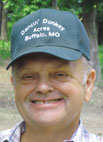
Miller Angus Ranch focuses on generations of quality females and quality bulls
SPOKANE, MO. – Recently, Rick Miller, owner of the Miller Angus Ranch near Spokane, Mo., took his mare and showed his cutting horse skills in the Intermediate Amateur division in a competition in Fort Worth, Texas.
“Professionals ride every day and train horses,” noted Rick. “Amateurs like me might show once every three or four months.” But, when it comes to raising championship Angus cattle, Rich is all pro.
Rick was raised on a family farm just north of Kimberling City, Mo., on land that his grandparents and parents farmed.
“We’ve been around here a long time,” he said.
Rick and his wife Leslie bought their current property in 1995. Over time, they added parcels and now own upwards of 750 acres. They have 78 acres of hayfields planted in Triticale, a hybrid of wheat and rye. After wrap baling the mature Triticale they replant with Sudangrass. The Millers are a very close family. Their son, two daughters and multiple grandchildren all live nearby, most on adjoining properties.
What has really set the Miller Angus Ranch apart is their focus on genetics using Artificial Insemination coupled with natural breeding to build a signature herd. The Miller Angus Ranch has incorporated AI for nearly 15 years.
“It’s pretty labor intense,” Rick said of AI, but added that, “The quality of the cattle has gotten a lot better.”
The Miller operation concentrates on producing females.
“I think if you produce really good females,” Rick said. “The steers will take care of their selves.”
Rick said they generally retain 25 virgin heifers each season and plans to sell any above that number that may come out of this year’s calvings.
“We run about 150 head of spring cows and a hundred head of fall cows,” Rick explained.
Beginning a 30-day protocol the second week of March, the Miller Ranch operations placed Controlled Intravaginal Drug Release (CIDR) devices into their virgin heifers.
After the CIDRs are pulled, the heifers are given an injection of Lutalyse then an injection of GnRH (gonadotropin-releasing hormone) a few days later when they are breed. For their mature cows the protocol timing is about 10 days. This season the Miller Angus operations worked to complete the spring process by April 25 such that the animals begin calving the last week in January.
“You always have a few cows that calve a little early,” Rick noted. “Even if you breed them all on the same day they’ll be scattered out over two or three weeks.”
Miller Angus Ranch uses one clean up bull per set of cows. After monitoring the cattle for about a week following AI, they put a bull in with the set of cows that were stimulated together for 65 days to naturally breed those cows in which the AI may have not taken. Rick said they realize an AI success rate of 50 to 60 percent. This year they’re trying an approach that uses semen designed to produce all female calves.
“You have a little bit less conception rate with sexed semen than you do with conventional,” Rick said.
This spring, the Millers introduced female sexed semen into their first-calf heifers from a bull named Raven Republic owned by ABS Global, and for another set of 150 cows sexed semen was used from a bull called Identified, co-owned by ABS Global and Stratford Angus in Pratt, Kan.
Miller’s operation is primarily Angus, but also there are also some foundation Hereford genetics.
“We run Line One horned Hereford bulls,” Rick said.
In 1934 at the Miles City, Mont., Fort Keogh Livestock and Range Research Laboratory (LRRL), Line One was created as a way for cattlemen to capture heterosis – or hybrid vigor – and produce a consistent product by crossing inbred lines, according to LRRL geneticist Michael MacNeil. Imbued with heterosis traits the Hereford-Angus cross female is today considered one of the best females available for commercial beef production in that these particular crossbred cattle have high fertility, are long-lived, and thrive in temperate regions.
Last summer, Rick toured the 55,000 acre Montana LRRL Research Station and bought two young Line One bulls in March from the Cooper Hereford Ranch in Willow Creek, Mont.
The Millers also own a mature Line One Hereford bull they bought from Holden Herefords in Valier, Mont.
“We breed those baldy cows back to black, and the black cows back to Hereford,” Rick explained.
“The black baldy calves and mothers have always been top sellers at the market for years and years.”
Miller Angus sells most of their cattle at the Joplin Regional Stockyards and MFA pre-vac sales in Joplin, Mo. In preparation for pre-vac sales, it is generally accepted that producers have taken extra measures to ensure that their cattle present well. They do this through a variety of quality improving regimens and health programs. Bulls are castrated and heifers must be guaranteed open and dehorned.
After selective genetics, an integral part of producing a prize herd is record keeping. Rick and his operations partner Holy Adams, the youngest of his three children, work constantly to monitor and record the progress of their cattle. They frequently ride through the lots over time taking notes and observing the animals’ development. They know when their cows and heifers are due to calve. But, Rick warned, using this iterative and date specific process one needs to be prepared
“Because it could be a snowstorm. You might get 14 or 15 calves the same day,” he said.
The upside, however, is consistently sized calves that not only arrive but mature at the same time.
The Millers know who the sire and dam are of each animal and the genetic lines from which they are descendant.
“You start stacking these cattle generation upon generation with proven bulls,” stated Miller, “and (the herd) just gets better. It just gets better.”







